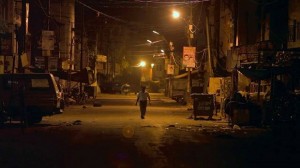By TANUL THAKUR
At one point in the 82-minute documentary Katiyabaaz, Loha Singh proudly displays the gashes on each of his right hand fingers. These patches, some larger than others, are devoid of skin, and appear pale white, not very different from the colour of Singh’s fingernails. “This one was burnt,” Singh begins cupping each right hand finger with his left hand, describing how he got these scars, “this one was burnt too, and then this one, then this one, and then this one.” He points to his left index finger: “A wire had protruded here.” He places his right hand on his left thumb, “and here,” palm, “and here,” wrist, “and here.” Singh didn’t get these scars in an accident; he got them while earning his living. He’s a katiyabaaz (an electricity thief). Katiyas (illegal wires used to source electricity) are so common in Kanpur that katiyabaaz is not a pejorative, but a badge of honour for people like Singh — ones who steal power from the privileged to give it to the poor.
The opening frames of Katiyabaaz shows us a Kanpur that’s still hungover on its glorious past. The camera lingers over the dilapidated insides of the factories that have been long defunct (a lot of nationalised mills shut down in the city in the early ’90s); the chimneys of some of these factories, however, still belch fumes in the sky, as if desperately drawing attention to what the city was; some Victorian factory mills still stand tall, their boards insist on spelling Kanpur as “Cawnpore”.
Fahad Mustafa and Deepti Kakkar, filmmakers of Katiyabaaz, during research for the film, found out that this Kanpur — or “Cawnpore” — still lives with some Kanpuriyas (as the denizens of the city are usually called). They met people from the city who often took vacant solace in the fact that “Kanpur was once called the Manchester of the East” — in the film, even the then Prime Minister Manmohan Singh begins his speech by using this overused epithet — but now, “hum keede makodon ki zindagi jee rahe hain (we are living like insects)”. “There is a huge sense of lost pride. They often talk of the good times of the past, ‘bahut shandaar shehar hua karta tha (it used to be a great city),” says Fahad Mustafa. “So there’s a sense of misfortune and jadedness with a lot of things.” Moreover, the continual absence of “light” — or electricity — from their city does nothing but underlines their current, unfulfilled lives.
Loha Singh, the film’s protagonist, is as an ideal prism to examine the city’s various quandaries. Singh’s father lost his job due to the mills being shut down some two decades ago; he responded to this cruel vagary by working as a minion in a chai shop. Eight years later, he became a katiyabaaz. But Loha Singh is not a victim; at least the film doesn’t see him as one: when he hurls his ladder at one of the many electricity poles in the city to illegally route electricity to his fellow lesser privileged workmen, the camera plainly observes him like a close confidante, accompanied by a playful background score, as if goading him on. You don’t — or quite possibly cannot — judge a way of life, can you?
But, we soon realise, this stealing of electricity is not even a part time solution for the pauper denizens of Kanpur; at best it’s a pleasant, forgetful diversion from their unremarkable lives because the real, debilitating problem lies elsewhere. The power crisis in the city arises due to a severe disconnect between the demand and supply. Ritu Maheshwari, a newly appointed MD of Kanpur Electricity Supply Company Limited (KESCO), makes it clear to her subordinates that people who don’t pay their bills on time shouldn’t get access to electricity. “People think that just because they are poor, they should get electricity free of cost,” says Maheshwari.
She opens specialised ATMs in the city that enables people to pay their bills, opens up hotlines where they can inquire about the details of the various power outages, and patiently listens to their problems. But she can only have that much of an effect: KESCO is just a distribution company that relies on the electricity generated in the state. The film was shot in 2012, when the demand easily outscored the supply. But even in subsequent years, not a lot has changed. According to the 2013 and the 2014 Central Electricity Reports, the power deficit in Uttar Pradesh amounted to 16.6% and 15.11%, a sharp contrast to states such as Delhi and Harayana, where the power deficit averaged to around 0.5%. These problems don’t lend themselves to an immediate, easy answer, and the film isn’t interested in arriving at one. Instead, it seeks to examine what the people of Kanpur choose to do with these questions.
And it’s not a pretty picture — people line up in front of the KESCO offices demanding Maheshwari’s resignation; they gravitate towards a local politician, Irfan Solanki, who quite astutely makes this pressing social problem an important part of his election manifesto. Earlier in the film, he storms into Maheshwari’s office, demanding a solution to this problem. When Maheshwari takes object to his insolence, he lashes out at her. Later, while addressing an election rally, he says this about her: “Ek toh mahila, upar se IAS. Itna ghamand (A woman, and on top of it an IAS officer — how arrogant)?”
A few months later, Solanki won the election by a thunderous margin. And around the same time, a new board was put up on Maheshwari’s office wall: “4-4-2011 to 25-3-2012.” In offices of people like Ritu Maheshwari, the writing invariably appears on the wall.
And then there’s Loha Singh, cocooned in his own world, almost always using his braggadocio demeanour as some sort of defence mechanism.
He is also not interested in any sort of a future, choosing to spend his entire day’s earnings on cheap country alcohol, the same night. On one such night, when he exits a shanty bar with slurry speech and stuttering feet, the camera cranes upwards, framing him slip into the darkness of the night — at that moment, there’s no way you can distinguish this Kanpuriya from Kanpur: both of them are famished, powerless and more than a little intoxicated.
(An edited version of this was published in The Sunday Guardian)
Tanul Thakur (@Plebeian42) is an independent, award-winning film critic and journalist.
He blogs at tanulthakur.wordpress.com









Leave A Comment
You must be logged in to post a comment.